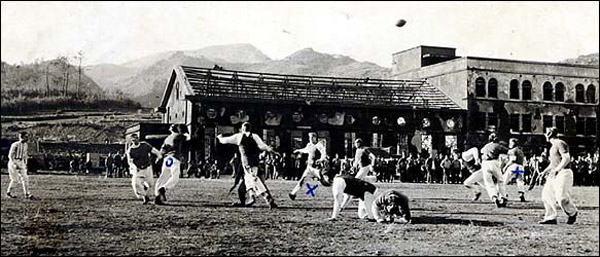
Football is a complex of systems. It's like no other sport. When the game is played properly, it's an interlocking of a number of systems. The individual. The small cluster he's part of. The larger unit, the eleven. People stress the violence. That's the smallest part of it. Football is brutal only from a distance. —Don DeLillo, End Zone
The atomic age began underneath Stagg Field at the University of Chicago; the old football powerhouse had done much to change the game, inventing an aerial attack that made the game more about skill and speed than sheer dumb force, a strategic change accepted to reduce a spate of fatalities that nearly ended the game in America. The university eventually gave up on football, and the seeds of the Manhattan Project were planted under the football field, the beginnings of aerial warfare meant to end all war by making its inevitable heightening too terrifying to contemplate.
Don DeLillo captured how the two games overlapped—you've likely heard of the nuclear football—in his 1986 novel End Zone, but in a rare instance of the world being weirder than DeLillo envisoned in his fiction, the era of the atomic bomb was bookended by football: the first bombs began under a football field, and after their sole use, a football game was played among the rubble, led by two of Chicagoland's great stars:
Back in the States, the Rose Bowl and other major college football bowl games, with the Great War over, were played as usual on New Year’s Day. To mark the day in Japan, and raise morale (at least for the Americans), two Marine divisions faced off in the so-called Atom Bowl, played on a killing field in Nagasaki that had been cleared of debris. It had been “carved out of dust and rubble,” as one wire service report put it.
Both teams had enlisted former college or pro stars for their squads. The “Bears” were led by quarterback Angelo Bertelli of Notre Dame, who won the Heisman Trophy in 1943, while the “Tigers” featured Bullet Bill Osmanski of the Chicago Bears, who topped pro football in rushing in 1939. Marines fashioned goal posts and bleachers out of scrap wood that had been blasted by the A-bomb. Nature helped provide more of a feel of home, as the day turned unusually chilly for Nagasaki and snow swirled.
More than 2000 turned out to watch. A band played the fight song, “On Wisconsin!” The rules were changed from tackle to two-hand touch because of all the glass shards remaining on the turf.
The game was meant to end in its own form of mutually assured destruction, but game theory is always complicated by human behavior:
The two captains had quietly conferred on another matter, too. According to Bertelli's son Mike, of Clifton, New Jersey, both had secretly agreed that to keep peace in the units, they would do everything in their power to end the game in a tie.
Bertelli tossed two touchdown passes to lead Nagasaki to a 13-0 halftime advantage, but Isahaya stormed back behind two scoring runs from Osmanski. With the second touchdown, Osmanski was one extra point from victory.
Despite the pregame pledge, Osmanski could not pass up the opportunity to beat Bertelli. The kick was converted and Isahaya won, 14-13.
Bertelli finished his football career with the Chicago Rockets, and moved back to New Jersey; Bullet Bill Osmanski, who had completed his studies as a dentist at Northwestern while leading their running attack (his career average of 4.8 yards per carry wasn't far behind Gale Sayers), retired the year after the Atomic Bowl to become a Chicago dentist; years later, his job included removing shrapnel from the mouth of Gov. Richard Ogilvie, a Purple Heart recipient as a tank commander in France.
Photograph via CONELRAD Adjacent


